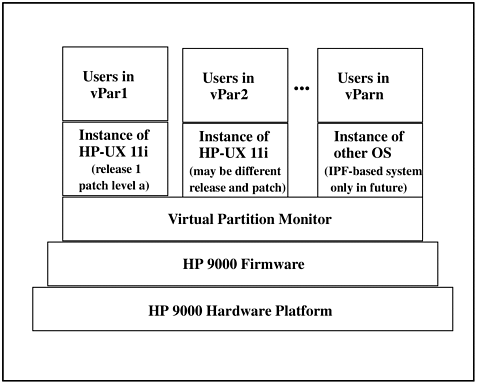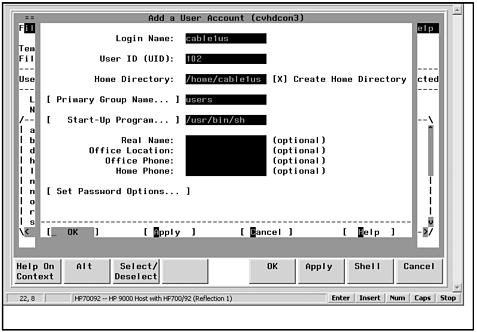| Each Virutal Partition is like a separate server. This means that you have separate users in your respective Virtual Partitions. Any user-related information that needs to be shared between Virtual Partitions would be done in the same manner as sharing between physically separate servers. For instance, you may want to have users have the capability to remotely login from one Virtual Partition to another. You would accomplish this by setting up the appropriate network files in each Virtual Partition just as you would with separate servers (see Chapter 13 for Networking.) Figure 6-1 shows Virtual Partitions and the relationship to users: Figure 6-1. Virtual Partitions and Users  As Figure 6-1 shows, each Virtual Partition has its own instance of the operating system and its own set of users. The vPars are isolated from a software perspective, so it is just as if the users exist on different servers. In order to share information among users, such as a database of users, you would implement technology such as Network Information System (NIS). With NIS you could create a database of user information that would be shared among different systems, and in this case, different vPars because they are the same as different servers from a software standpoint. Let's now create a new user on each of the two vPars. On cable1 we'll create the user cable1us and verify that this user does not exist on cable2.On cable2 we'll create the user cable2us and verify that this user does not exist on cable1. See the background portion of this chapter for detailed information on creating users. Figure 6-2 shows a System Administration Manager (SAM) screen shot of creating a user cable1us in vPar cable1: Figure 6-2. Creating cable1user in SAM  Figure 6-2 shows the hostname of cvhdcon3, which is the server name corresponding to vPar cable1. The user cable1us was created in vPar cable1 and exists only in cable1. We 'll verify this shortly. We performed the same procedure creating user cable2us in vPar cable2 using SAM. There should now be one user in cable1 that is not viewable in cable2, and vice versa. The following shows connecting to cable1 and listing the contents of /etc/passwd. cvhdcon3:/ # cat /etc/passwd root:hiIXKsAzUIFy6:0:3::/:/sbin/sh cable1 listing daemon:*:1:5::/:/sbin/sh bin:*:2:2::/usr/bin:/sbin/sh sys:*:3:3::/: adm:*:4:4::/var/adm:/sbin/sh uucp:*:5:3::/var/spool/uucppublic:/usr/lbin/uucp/uucico lp:*:9:7::/var/spool/lp:/sbin/sh nuucp:*:11:11::/var/spool/uucppublic:/usr/lbin/uucp/uucico hpdb:*:27:1:ALLBASE:/:/sbin/sh nobody:*:-2:-2::/: www:*:30:1::/: webadmin:*:40:1::/usr/obam/server/nologindir:/usr/bin/false smbnull:*:101:101:DO NOT USE OR DELETE - needed by Samba: /home/smbnull:/sbin/sh opc_op:*:777:77:OpC default operator:/home/opc_op:/usr/bin/ksh cable1us::102:20:,,,:/home/cable1us:/usr/bin/sh <-- cable1us cvhdcon3:/ # This listing for cable1 shows that cable1us exists in the /etc/passwd file on cable1; however, there is no cable2us present in this file. The following shows connecting to cable2 and listing the contents of /etc/passwd. # cat /etc/passwd cable2 listing root:Jx66ARmhj.aBs:0:3::/:/sbin/sh daemon:*:1:5::/:/sbin/sh bin:*:2:2::/usr/bin:/sbin/sh sys:*:3:3::/: adm:*:4:4::/var/adm:/sbin/sh uucp:*:5:3::/var/spool/uucppublic:/usr/lbin/uucp/uucico lp:*:9:7::/var/spool/lp:/sbin/sh nuucp:*:11:11::/var/spool/uucppublic:/usr/lbin/uucp/uucico hpdb:*:27:1:ALLBASE:/:/sbin/sh nobody:*:-2:-2::/: www:*:30:1::/: webadmin:*:40:1::/usr/obam/server/nologindir:/usr/bin/false sam_exec:xxx:0:1::/home/sam_exec:/usr/bin/sh cable2us::101:20:,,,:/home/cable2us:/usr/bin/sh <-- cable2us # This listing for cable2 shows that cable2us exists in the /etc/passwd file on cable2; however, there is no cable1us present in this file This listing shows that the unique users for the respective vPars exist only on the vPar on which they were created. In addition, each vPar has its own root and other system-level users. Next let's look at setup information of individual users in vPars. |